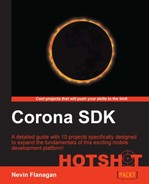In puzzle games, it's important to consider alternate solutions. It's especially important in games where some moves cannot be reversed, such as pushing a box into a corner. We'll use the game history we've accumulated to step backward and reverse our most recent move when the user shakes the device.
Our design says that the user should be able to undo their last move by shaking the device.
Shaking is recognized by looking at the accelerometer events. These events are dispatched only to the global Runtime target; our UI will need to listen to this target, and stop listening when its scene is not active, but ideally we don't want the game scene to know that a submodule needs to be connected to Runtime or disconnected later. Perform the following steps to recognize the Undo requests:
- Since the interface for the game scene is generated in the
createSceneevent, the interface can register and unregister itself by listening to theSceneobject for theenterSceneandexitSceneevents. We'll add the functions to listen or stop listening toRuntimefirst, ininterface.lua:local function engage(self, event) Runtime:addEventListener('accelerometer', self) end local function disengage(self, event) Runtime:removeEventListener('accelerometer', self) end return function(game)
- Then we just need to attach the following functions to the interface when it is constructed, and start listening for the right scene events:
target:addEventListener('tap', self) self.enterScene = engage game:addEventListener('enterScene', self) self.exitScene = disengage game:addEventListener('exitScene', self) local counter = display.newText(self, "0", 10, 10, native.systemFont, 24) - And finally, since the interface object itself is being registered as the listener for the
accelerometerevents, it needs an appropriate method:game:addEventListener('exitScene', self) function self:accelerometer(event) if event.isShake then self:dispatchEvent{name = 'Move'; action = 'undo'} end end local counter = display.newText(self, "0", 10, 10, native.systemFont, 24)
Fortunately, we don't have to do any complex tracking of accelerometer data to recognize whether the user is shaking the device; Corona uses routines provided by the host OS to determine that for us.
So now the interface can dispatch the undo events for Move when the device is shaken. The Game object is already listening for the Move events on the interface, so we need to add some recognition to the existing routine. Open game.lua and find the scene:Move function.
if move.action == 'push' and checkWin(self.Map) then
self:dispatchEvent{name = 'Game'; action = 'stop', state = self.Map, Game = self}
end
elseif event.action == 'undo' then
end
endThe Move function currently only acts when the requested action is an attempt to move. When that's not the case, we can now check whether the Move was an undo request, instead.
The question then becomes how to restore the game back to its state before a given move. Fortunately, each Move event on the game that's either a push or step event contains the positions of the moving elements before the move was completed. So we can actually save these events themselves as a way of tracking the game history (specifically, the push events, since player steps don't meaningfully advance the game). Perform the following steps for saving move history and backing moves out:
- Right now, the game scene uses a number to count how many
pushevents have taken place. But since we're going to be saving them in chronological order in an array, we can use the length of that array to know how many moves have taken place instead. Find thescene:enterScenecode ingame.luaand change the following line:self.Map = require "map" (sok.load(event.params.File, event.params.Level)) self.MoveCount = 0 self.World:Load(self.Map)So that it reads the following:
self.Map = require "map" (sok.load(event.params.File, event.params.Level)) self.History = {} self.World:Load(self.Map) - We can then match the other code in
scene:Movethat formerly relied onMoveCountto this new system:if move.action == 'push' then table.insert(self.History, move) end move.count = #self.History self:dispatchEvent(move)
- Now that our pre-existing code is working on the new system, we can use the most recent
Moveevent in the history as a way of resetting theMoveaction:elseif event.action == 'undo' then local lastMove = table.remove(self.History) if lastMove then end end
The
ifblock just ensures that we don't attempt toundothe beginning of the game. - Since we don't save
stepevents in the history, we can't guarantee that the player is still in the position it was in immediately after the move being undone. Although the box pushed will be in the same position as it was in immediately after the move being undone, since this is the most recent push. So we get the player's current position from the map, clear that position, and set the player's position before the move being undone as his/her current position:if lastMove then local column, row = self.Map:FindPlayer() local realm = self.Map.Moving realm[row][column] = nil realm[lastMove[1].y][lastMove[1].x] = '@' end
- The local variable realm is just used to shorten our code and eliminate a lot of tedious repeating of table lookups. Then, we can fetch the box that was moved and restore it from the position it was moved to.
realm[lastMove[1].y][lastMove[1].x] = '@' local xFinal, yFinal = lastMove[2].x + lastMove.x, lastMove[2].y + lastMove.y realm[lastMove[2].y][lastMove[2].x] = realm[yFinal][xFinal] realm[yFinal][xFinal] = nil end
- Finally, we reload the world to match the current state of the
Mapentity (this is much easier than trying to regress it) and issue an event with the revised move count to force the interface to update.realm[yFinal][xFinal] = nil self.World:Load(self.Map) self:dispatchEvent{name='Move'; count = #self.History} end
At this point, undo should work. You can load the app to your device and test it the real way, or it will simulate device shakes although the simulator doesn't supply most accelerometer input.
